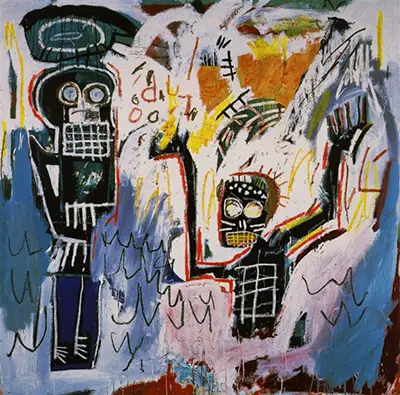Here we find two figures that are styled similar to traditional African art, reflecting the roots of Basquiat. Black forms are then touched with white lines to create detail, and the artist would normally use oil sticks which he enjoyed working with for these techniques. The left figure is standing tall, with a halo above their head, whilst the figure on the right is only included from the waist upwards, with arms open wide. The background is then filled with detail and expression, with swipes of wild colour and line. The artist would sometimes keep his backgrounds fairly simple, with just a single tone of colour, often yellow, but in this case wanted to fill every area of the canvas with exciting colour and interest.
The artist came from a background of graffiti and we can see elements of that within the style of this painting, and he also regularly used lettering within his paintings. His work is categorised as Neo-Expressionism which was a part of the New York art scene of the 20th century, and he would become one of the characters best known within that group. He would also count some major celebrities within his friendship circle, such as Andy Warhol, with the two artists working collaboratively on a number of occasions. Basquiat loved colour, normally bright tones, and within Baptism we find tones of blue, yellow, orange and red. He may have kept a small palette in order to avoid mixing colours in the way that the old masters would have worked.
Baptism is a respected and highly valuable piece from this artist's career but not quite as famous as his hightlights which included Hollywood Africans, Untitled Boxer, King Alphonso and Bird on Money. There are repeating themes across his work including his famous crown logo, as well as religious and political themes that work interchangeably. In the case of this painting he focuses on Baptism, and one can loosely determine the features of this artwork once we are aware of the overall direction of the content, though it still requires some research in order to fully understand any of his paintings. Recent publications have attempted to help us understand some of these pieces, often from spotting consistent items that stretch across his career and oeuvre.


